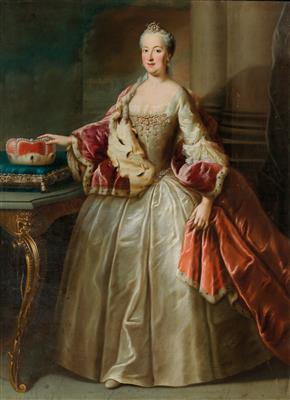Workshop of Georges Desmarées

(Österby 1697–1776 Munich)
Portrait of Maria Anna, Duchess of Bavaria, née Princess of Pfalz-
Sulzbach (1722–1790),
oil on canvas, 190 x 140 cm, framed
Provenance:
traditionally said to be a present from Prince Louis Napoleon (the future Emperor Napoleon III) to the physician Johann Marmor (1804– 1879), a friend during his exile on Lake Constance; Private collection, Austria
The sitter of the present painting, Duchess Maria Anna of Bavaria, is one of the most illustrious personalities from the House of Wittelsbach.
She was born in 1722, daughter to Count Palatine Joseph Charles of Sulzbach (1694–1729), the hereditary prince who died prematurely.
Her mother Elizabeth (1693–1728) was the daughter of Charles Philip, Elector of the Palatinate. In 1742 the princess married Prince Clement Francis de Paula of Bavaria (1722–1770), heir presumptive to the childless Prince Elector Maximilian III. The couple also remained childless. When the prince elector died in 1777 and the Bavarian main line of the House of Wittelsbach thus became extinct, Maria Anna stood up as fierce opponent of the Habsburgs, who raised claims to the succession in Lower Bavaria. These claims had in fact been recognised in a treaty with Austria (1778) by Maria Anna’s brother-inlaw Charles Theodore, the new Prince Elector, who was also childless. In order to preserve Bavaria’s independence, several patriots rallied behind Duchess Maria Anna and tried to convince Duke Charles August of Zweibrücken, the presumptive heir to the throne, to not cede Bavaria to Austria. Maria Anna herself secretly contacted King Frederick II of Prussia, whom she asked to halt Emperor Joseph II. On 6 February 1778, Charles August of Zweibrücken met Count Görtz, the Prussian envoy, at the duchess’s Munich residence, the so-called Maxburg. As a result of their encounter, the contract of succession of 15 January 1778 was declared void under official protests against Austria’s claims. Since this day, Maria Anna, whose role in this affair soon became publicly known, is known as ‘patrona Bavariae’.
In 1780, Duchess Maria Anna, meanwhile widowed, clandestinely married her rent master, Andreas André, who had long been her secret courier. Enraged because of this mesalliance, Prince Elector Charles Theodore banished André to Rieden on Lake Staffel, where the duchess owned an estate. In 1932 the German writer Horst Wolfgang Geißler published the novel Die Dame mit dem Samtvisier [The Lady with the Velvet Visor], which tells the life of Duchess Maria Anna.
The present painting was originally conceived as a half-length portrait. A later addition enlarged it into a full-length portrait.
Expert: Dr. Alexander Strasoldo
 Dr. Alexander Strasoldo
Dr. Alexander Strasoldo
+43 1 515 60 403
oldmasters@dorotheum.com
30.04.2019 - 17:00
- Dosažená cena: **
-
EUR 21.550,-
- Odhadní cena:
-
EUR 8.000,- do EUR 12.000,-
Workshop of Georges Desmarées
(Österby 1697–1776 Munich)
Portrait of Maria Anna, Duchess of Bavaria, née Princess of Pfalz-
Sulzbach (1722–1790),
oil on canvas, 190 x 140 cm, framed
Provenance:
traditionally said to be a present from Prince Louis Napoleon (the future Emperor Napoleon III) to the physician Johann Marmor (1804– 1879), a friend during his exile on Lake Constance; Private collection, Austria
The sitter of the present painting, Duchess Maria Anna of Bavaria, is one of the most illustrious personalities from the House of Wittelsbach.
She was born in 1722, daughter to Count Palatine Joseph Charles of Sulzbach (1694–1729), the hereditary prince who died prematurely.
Her mother Elizabeth (1693–1728) was the daughter of Charles Philip, Elector of the Palatinate. In 1742 the princess married Prince Clement Francis de Paula of Bavaria (1722–1770), heir presumptive to the childless Prince Elector Maximilian III. The couple also remained childless. When the prince elector died in 1777 and the Bavarian main line of the House of Wittelsbach thus became extinct, Maria Anna stood up as fierce opponent of the Habsburgs, who raised claims to the succession in Lower Bavaria. These claims had in fact been recognised in a treaty with Austria (1778) by Maria Anna’s brother-inlaw Charles Theodore, the new Prince Elector, who was also childless. In order to preserve Bavaria’s independence, several patriots rallied behind Duchess Maria Anna and tried to convince Duke Charles August of Zweibrücken, the presumptive heir to the throne, to not cede Bavaria to Austria. Maria Anna herself secretly contacted King Frederick II of Prussia, whom she asked to halt Emperor Joseph II. On 6 February 1778, Charles August of Zweibrücken met Count Görtz, the Prussian envoy, at the duchess’s Munich residence, the so-called Maxburg. As a result of their encounter, the contract of succession of 15 January 1778 was declared void under official protests against Austria’s claims. Since this day, Maria Anna, whose role in this affair soon became publicly known, is known as ‘patrona Bavariae’.
In 1780, Duchess Maria Anna, meanwhile widowed, clandestinely married her rent master, Andreas André, who had long been her secret courier. Enraged because of this mesalliance, Prince Elector Charles Theodore banished André to Rieden on Lake Staffel, where the duchess owned an estate. In 1932 the German writer Horst Wolfgang Geißler published the novel Die Dame mit dem Samtvisier [The Lady with the Velvet Visor], which tells the life of Duchess Maria Anna.
The present painting was originally conceived as a half-length portrait. A later addition enlarged it into a full-length portrait.
Expert: Dr. Alexander Strasoldo
 Dr. Alexander Strasoldo
Dr. Alexander Strasoldo
+43 1 515 60 403
oldmasters@dorotheum.com
|
Horká linka kupujících
Po-Pá: 10.00 - 17.00
old.masters@dorotheum.at +43 1 515 60 403 |
| Aukce: | Obrazy starých mistrů |
| Typ aukce: | Salónní aukce |
| Datum: | 30.04.2019 - 17:00 |
| Místo konání aukce: | Wien | Palais Dorotheum |
| Prohlídka: | 20.04. - 30.04.2019 |
** Kupní cena vč. poplatku kupujícího a DPH
Není již možné podávat příkazy ke koupi přes internet. Aukce se právě připravuje resp. byla již uskutečněna.
